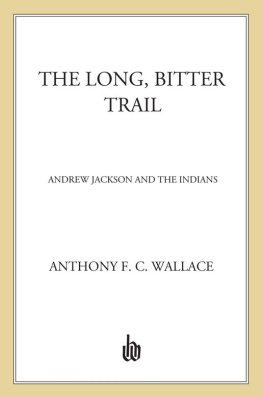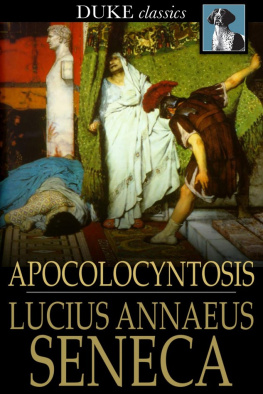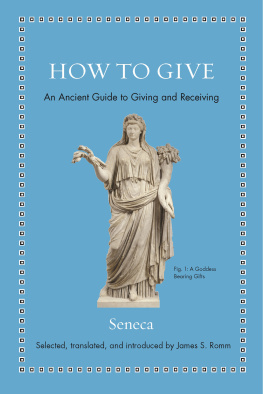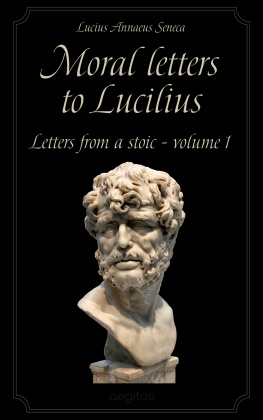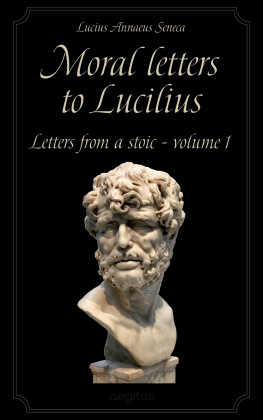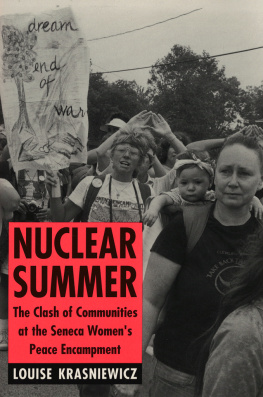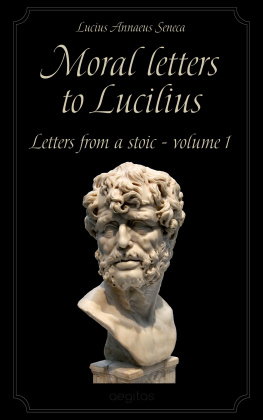Anthony Wallace - Death and Rebirth of Seneca
Here you can read online Anthony Wallace - Death and Rebirth of Seneca full text of the book (entire story) in english for free. Download pdf and epub, get meaning, cover and reviews about this ebook. year: 2010, publisher: Knopf Doubleday Publishing Group, genre: Home and family. Description of the work, (preface) as well as reviews are available. Best literature library LitArk.com created for fans of good reading and offers a wide selection of genres:
Romance novel
Science fiction
Adventure
Detective
Science
History
Home and family
Prose
Art
Politics
Computer
Non-fiction
Religion
Business
Children
Humor
Choose a favorite category and find really read worthwhile books. Enjoy immersion in the world of imagination, feel the emotions of the characters or learn something new for yourself, make an fascinating discovery.

- Book:Death and Rebirth of Seneca
- Author:
- Publisher:Knopf Doubleday Publishing Group
- Genre:
- Year:2010
- Rating:5 / 5
- Favourites:Add to favourites
- Your mark:
- 100
- 1
- 2
- 3
- 4
- 5
Death and Rebirth of Seneca: summary, description and annotation
We offer to read an annotation, description, summary or preface (depends on what the author of the book "Death and Rebirth of Seneca" wrote himself). If you haven't found the necessary information about the book — write in the comments, we will try to find it.
Death and Rebirth of Seneca — read online for free the complete book (whole text) full work
Below is the text of the book, divided by pages. System saving the place of the last page read, allows you to conveniently read the book "Death and Rebirth of Seneca" online for free, without having to search again every time where you left off. Put a bookmark, and you can go to the page where you finished reading at any time.
Font size:
Interval:
Bookmark:
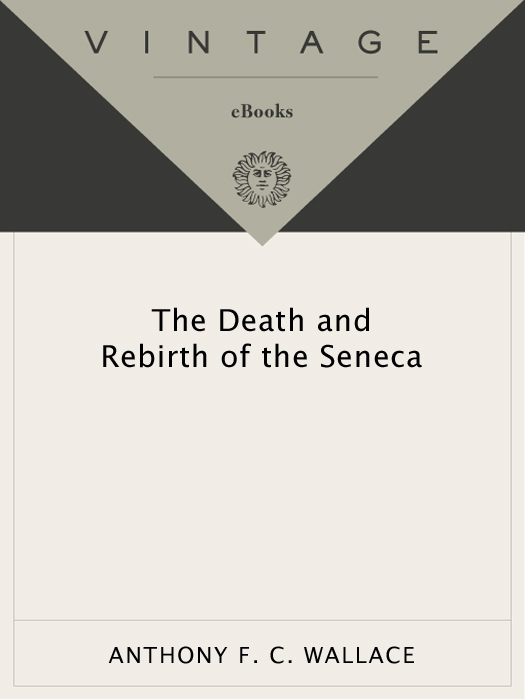
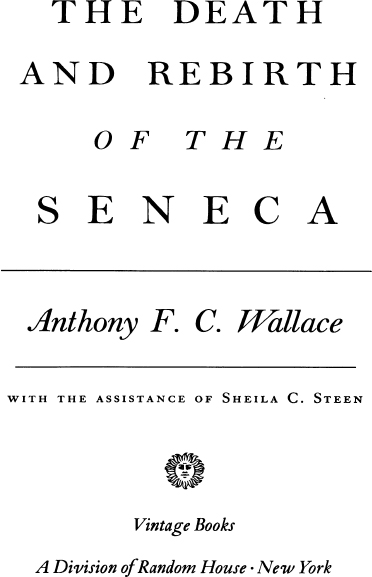
TO BETTY
T HIS BOOK TELLS THE STORY OF THE LATE COLONIAL AND EARLY reservation history of the Seneca Indians, and of the prophet Handsome Lake, his visions, and the moral and religious revitalization of an American Indian society that he and his followers achieved in the years around 1800. It is not intended to convey in a formal manner my theoretical views on social movements, although the case of Handsome Lake originally led me to consider the subject in a comparative frame of reference. For my general writings on revitalization movements, and for studies of special aspects of the Handsome Lake religion, the reader is referred to the several books and papers listed in the bibliography. Nor does the book attempt to describe in close detail the Iroquois cultures. The interested reader may consult the works of Morgan, Speck, Fenton, Shimony, Lounsbury, and others listed in the bibliography for further ethnographic information.
Library and field research in preparation for the book were begun in 1951 and largely completed by 1956; writing and analysis have been done on and off during subsequent years. Thus the dates of reference for recent events on the Allegany Reservation are the early 1950s. Much of the reserve, however, is now gone, covered by the water behind Kinzua Dam; the peopleand the religious centerhave been moved to new locations. Several persons have been of great help in collecting materials and in achieving interpretation. In particular I want to express gratitude to Mr. Merle H. Deardorff, who gave freely of time, wisdom, and extensive files of notes and photostats, all of which have been invaluable both in the accumulation and in the understanding of data; to W. N. Fenton, C. E. Congdon, Oscar Nephew, and Paul A. W. Wallace, for illuminating discussion; to the Social Science Research Council and the University of Pennsylvania for, respectively, a Faculty Research Fellowship (19523) and a research grant (1953), which permitted the collection of data and much of the writing; to Sheila C. Steen for loyal and creative research assistance; and to Josephine H. Dixon and Marilyn Crill for patient and careful secretarial work. To my wife Betty I extend thanks for typing, discussion, and for helpful encouragement. And to many unnamed Iroquois people go my gratitude for instruction and hospitality and my admiration for their creationthe religion of Handsome Lake.
A NTHONY F. C. W ALLACE
Philadelphia, Pa.
July, 1967
P ART I /
P ART II /
P ART III /
A Map of the Iroquois Country in the 18th and early 19th centuries and a map of the Seneca Reservations in 1797 appear on the following pages.
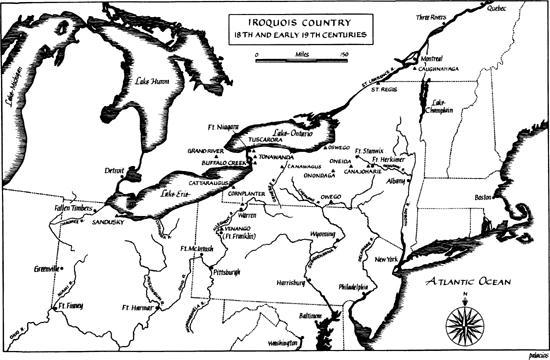
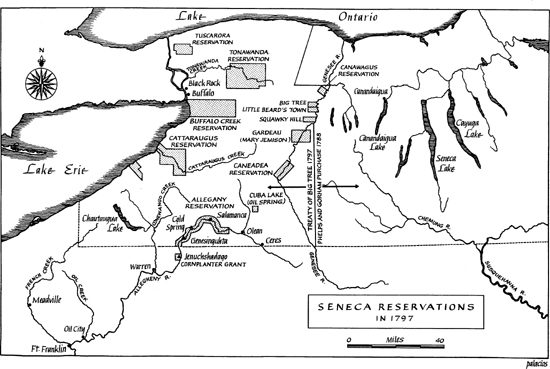

INTRODUCTION
 1
1 
T HE OLD WAY OF HANDSOME LAKE IS AN AMERICAN INDIAN religion that is still practiced on Iroquois reservations in the United States and Canada. It is not Christian, although it includes some elements borrowed from Christianity; it is essentially an amalgam of ancient tradition and the innovations of the Seneca prophet named Handsome Lake. It was developed by several tribes of Iroquois who, a century and a half ago, felt a need to lift themselves from defeat, demoralization, and despair and to revitalize their communities. This book tells the story of the origin of their religion: how the Iroquois lived before catastrophe befell them; what the disaster was like; and how Handsome Lake and his disciples designed for themselves and their people a new way to live and brought about a renaissance of Iroquois society.
A MONG THE TWENTY THOUSAND or so Iroquois Indians living on the several reservations in New York State, Quebec, and Ontario today, there are perhaps five thousand followers of the Old Way of Handsome Lake.of Handsome Lake followers, or longhouse people, or the pagans, as they are variously called. The Handsome Lake religion does not demand that its communicants rigorously avoid all other denominational affiliations. Thus many Handsome Lakers attend church or mass at times, and at times the longhouse, deriving benefit from both, each in its proper season. Many Baptists, and Mormons, and Episcopalians, on occasionparticularly at the high festivals of New Year and Green Corndrop in at the longhouse to listen gravely to the Gaiwiio (the good word, the Code of Handsome Lake), to partake of strawberry juice and corn soup, and to smile gratefully at the antics of the False Faces soliciting tobacco. There is good in both, they say, in the Handsome Lake way and in the Christian way. Some of the Seneca prophets followers even aver that Christ was one of the four angels who taught Handsome Lake the Gaiwiio, but doctrine is not settled on this point.
The Handsome Lake religion now, more than one hundred and fifty years after its conception, is embodied in an organization that has no formal name or address, as a Christian denomination might have, but that nevertheless functions in almost every way as a church. Its headquarters is on the Seneca Reservation at Tonawanda (near Buffalo, New York), where are kept the wampum belts of Handsome Lake himselfbelts so sacred that, according to legend, no white man has ever seen them, so sacred that even the preachers may read them only once every two years on a sunny day when no fleck of cloud, even so big as a mans hand, can be seen in the sky. On each of the New York reservations (except Tuscarora, near Niagara Falls) there is a longhouse. The term longhouse, used in its religious sense, includes the council house itself, where the Handsome Lake meetings (in addition to other community functions) are held; the general congregation of Handsome Lake followers; and the specific organization (including preachers and lay functionaries), which arranges the annual calendar of services. There are longhouses on the Allegany Reservation (near Salamanca, New York), on the Cattaraugus Reservation (near Gowanda), at Tonawanda (near Buffalo), at Onondaga (near Syracuse), at Oneida (on the Thames River in Ontario), at St. Regis (along the St. Lawrence River), at Grand River (near Brantford, Ontario), and at Caughnawaga (near Montreal). Handsome Lake himself did not design the organization that now carries on his work. He founded the religion; his followers organized its practice.
The Seneca Reservation on the Allegheny River, where Handsome Lake once lived, extends in a long, thin strip along the oxbow from the New York-Pennsylvania state line, east almost as far as Olean, and encompasses the city of Salamanca, whose white inhabitants lease their land from the Indians. It is about forty-two miles long and contains forty-two square miles. Driving through it in 1950, before the Kinzua Dam flooded much of the low-lying area, on a good macadam highway, one would see a scattering of old farmhouses, log cabins, and brightly painted prefabricated ranch-style bungalows with television antennas stretching skyward here and there to escape the mountain screen that rises on both sides of the river. At Onoville, Quaker Bridge, and Red House there are country stores, filling stations, and small clusters of houses. Many of the men divide their time between working for the Erie Railroad, which runs through the reserve, cultivating their gardens, and working around the house. The women are housewives; some of them serve as domestic servants, secretaries, and factory workers in Salamanca, Olean, or Jamestown. Many of the fields are growing up in weed and wood because farming, a century ago the economic mainstay of the people, is less profitable today than wage work. There are no real-estate taxes to pay. About eleven hundred Seneca people live on the reserve: white men in respect to their names, their manner of dress, and means of earning a living; Indians in their view of themselves as a minority group, separated from the surrounding world by the legal and economic arrangements that make up the reservation system, and identified with an Indian past. Great events in their history are not Columbus, and Plymouth Rock, and the Declaration of Independence. Rather, they remember, dimly and often not too accurately, the founding of the League of the Iroquois, the days of glory when an Iroquois hunter could walk safely from the Atlantic Ocean to the Miami River in Ohio, the dark days of Sullivans Campaign, when their villages were burned, the disastrous treaties at Fort Stanwix and Big Tree and Buffalo Creek, the treaty at Canandaigua, which guaranteed their lands and which was overturned by Congress in order to build the dam, and the great revival led by Handsome Lake.
Font size:
Interval:
Bookmark:
Similar books «Death and Rebirth of Seneca»
Look at similar books to Death and Rebirth of Seneca. We have selected literature similar in name and meaning in the hope of providing readers with more options to find new, interesting, not yet read works.
Discussion, reviews of the book Death and Rebirth of Seneca and just readers' own opinions. Leave your comments, write what you think about the work, its meaning or the main characters. Specify what exactly you liked and what you didn't like, and why you think so.

